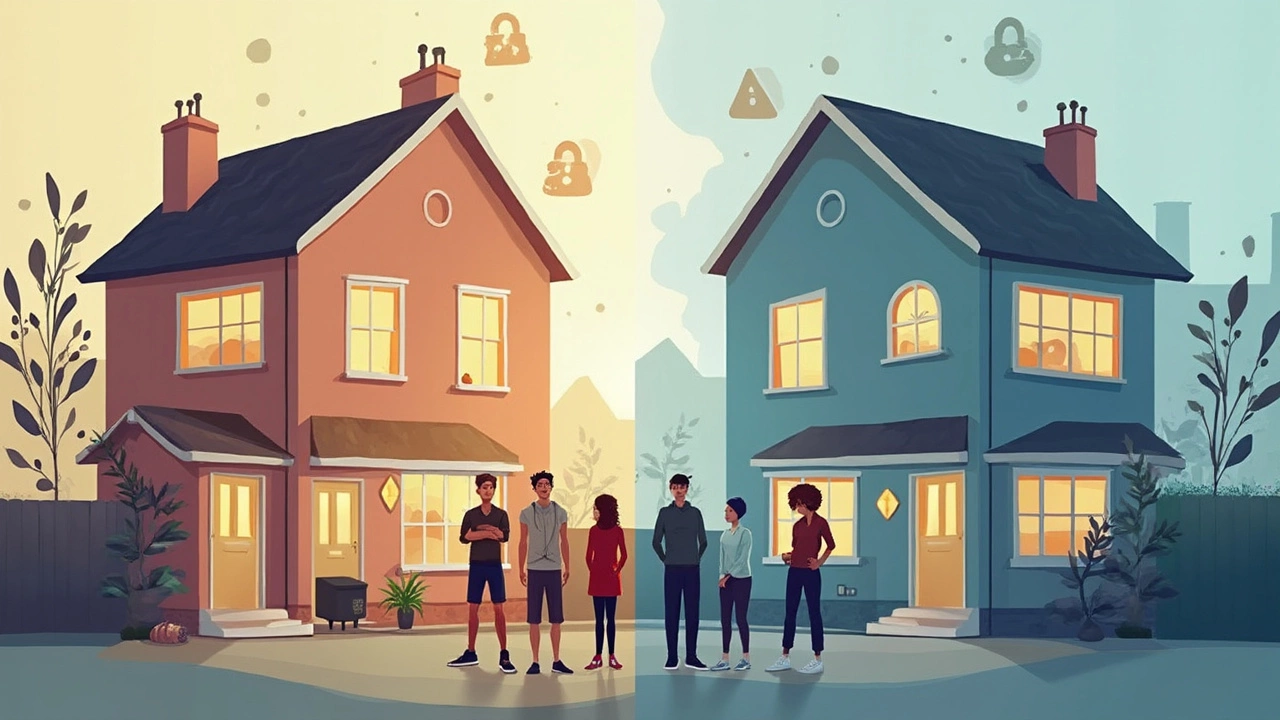If you’re shopping for your first home, someone’s probably mentioned FHA loans. They sound like an easy ticket in, right? You hear about the low down payments (as little as 3.5%) and flexible credit scores. But here’s the thing nobody brags about: FHA loans come with some drawbacks that could hit your wallet and your plans.
For starters, you’re going to pay extra for something called mortgage insurance. Unlike regular insurance for your stuff, this is just coverage for the lender in case you stop making payments. You’re stuck paying it every month, plus a big upfront fee—sometimes for years. That extra payment means you might qualify for a smaller loan, and your house payments could be higher than with some other types of loans.
- FHA Loans: Why Are They So Popular?
- Mortgage Insurance: The Hidden Cost
- Property Rules and Red Tape
- When FHA Can Cost You More
- Smart Alternatives and Pro Tips
FHA Loans: Why Are They So Popular?
Ask almost any first time homebuyer why they looked at an FHA loan, and they'll bring up the down payment. A regular mortgage usually needs at least 5% or even 20% down. But with FHA, you can buy with as little as 3.5% down—even if your credit score is less than perfect. For a lot of people struggling to save up or those with bumps on their credit, that’s a game-changer.
There’s also the fact that lenders are more chill about your history. With FHA, you could get approved even with a score around 580, where most banks would laugh you out the door for a normal loan. The rules on past bankruptcies or foreclosures aren’t as strict either.
Here’s a quick point-by-point on why these loans keep popping up:
- Low down payment: You can buy a home with 3.5% down if your credit score is at least 580.
- Lower credit needed: Some lenders consider scores as low as 500 (though you’ll need at least 10% down at that point).
- Help with closing costs: Sellers can pay up to 6% of your closing costs with FHA—way more than many other loans allow.
- Flexible guidelines: That includes past money troubles or gaps in employment.
FHA loans aren't just for poor credit either. Many people use them because they can’t put 20% down or want a safety net just in case their finances aren’t perfect. They’ve become a go-to for first timers, and in 2024 about 15% of all home loans in the U.S. were FHA—so you’re definitely not alone.
Mortgage Insurance: The Hidden Cost
One of the biggest drawbacks of an FHA loan is mortgage insurance. It’s not optional. Whether your down payment is small or bigger, you pay for it—both upfront and every single month. The first hit comes as an Upfront Mortgage Insurance Premium (UFMIP). Most buyers pay 1.75% of the loan amount at closing. For a $300,000 house, that’s $5,250 just for getting started. Most people add it to their loan instead of paying it up front, which means you’ll pay interest on that insurance too.
But wait—there’s the monthly bill. FHA loan holders pay an annual Mortgage Insurance Premium (MIP) split into monthly payments. It typically ranges from 0.55% to 0.75% of the loan balance. Your credit score doesn’t get you out of this, and the fee is the same no matter how great your finances are. Conventional loans sometimes waive private mortgage insurance (PMI) once you have 20% equity, but FHA’s rules are stricter. In most cases, unless you make a 10% down payment, you’re stuck paying monthly MIP for the entire length of your loan. Make 10% down, and you’ll still pay for 11 years.
| Down Payment | Monthly MIP Length | Can Drop Like PMI? |
|---|---|---|
| Less than 10% | Full term (30 years) | No |
| 10% or more | 11 years | No |
The real cost adds up over time. You could shell out tens of thousands in mortgage insurance with an FHA loan, way more than with some first time homebuyer options. That’s money you don’t see again—it protects the lender, not you. Before jumping in, always run the numbers. A slightly higher down payment or fixing your credit could open the door to other loans with lower long-term costs.

Property Rules and Red Tape
If you’re eyeing an FHA loan, you need to know there’s quite a bit of red tape when it comes to the actual house you buy. The feds don’t want to guarantee a loan on just any place—they have tons of rules for what kind of property qualifies. This can trip up first time homebuyers who fall in love with a place before checking if it’s FHA-approved.
First, the home has to meet certain safety and health standards. That means the FHA sends out its own appraiser who looks for chipped paint, broken windows, water leaks, old roofs and more. If something’s wrong, they’ll make you or the seller fix it before you can close. This process slows things way down. Sellers sometimes won’t bother dealing with FHA loan buyers because of the extra hassle.
Want to buy a fixer-upper? FHA loans don’t always work. Regular FHA loans require the house to be “move-in ready.” Even their special renovation loan, called a 203(k), has its own complicated list of approved repairs and contractors.
- Condos? They must be in FHA-approved developments—just because you like a unit, doesn’t mean you can get it with an FHA loan.
- No investment properties. You’ve got to live in your new place at least a year—rentals or vacation homes aren’t allowed.
- Flipping? FHA has anti-flipping rules: you usually can’t buy a home that’s changed hands in the past 90 days.
There’s even more fine print for rural properties, manufactured homes, or houses with quirky features. A simple two-month closing on a “normal” house can turn into a four-month stress-fest if the appraiser digs up problems.
Here’s a quick look at common FHA property pitfalls:
| Rule | What It Means |
|---|---|
| Strict Appraisal | Extra repairs may be required before you get the loan. |
| Condo Approval | Not all condos are eligible for FHA loans—whole building must be approved. |
| Primary Residence Only | You have to live there at least one year. |
| Flipping Limit | No fast resales; owners must wait at least 90 days to sell to an FHA buyer. |
Bottom line: If you want a project or a place with some "character," a first time homebuyer using an FHA loan could hit a lot of walls before getting keys in hand.
When FHA Can Cost You More
This is where the FHA loan can become a money trap if you’re not careful. The biggest kicker is the ongoing mortgage insurance. With an FHA, there’s an upfront premium (usually 1.75% of your total loan amount) and a monthly insurance fee that for many borrowers just never goes away. Think about this: if you put down less than 10%, you’ll pay that insurance for the whole life of your loan—yep, all 30 years. That can add up big time versus other loan types where you can drop insurance after a few years.
You might also get stuck with a higher interest rate. Lenders know the government is backing you, so sometimes FHA rates can sound tempting, but when you factor in the insurance, your real cost could be higher than a loan like conventional with private mortgage insurance (PMI). For people with solid credit (think 700+), a conventional loan often results in a lower total monthly payment, even if the sticker rate itself looks a bit higher up front.
Let’s look at some sample numbers:
| Loan Type | Down Payment | Monthly Insurance | How Long You Pay Insurance |
|---|---|---|---|
| FHA Loan | 3.5% | 0.55% of loan/year | Up to 30 years |
| Conventional Loan (w/ PMI) | 5% | 0.2 - 1.5% of loan/year | Can drop after 20% equity |
Another downside is what happens when you want to refinance. Getting out of an FHA loan can take time and extra fees, because you’re trying to drop that stubborn insurance. And if home values drop, you might not even qualify to ditch it.
So who gets hurt most? People staying in their homes long-term or those who could have qualified for cheaper options just by waiting a few more months or cleaning up their credit. The bottom line: figure out what your total loan costs will be—not just up front, but for every year you’ll own the place. Sometimes that low entry cost just isn’t worth it over the long haul.

Smart Alternatives and Pro Tips
Before locking yourself into an FHA loan, it’s smart to check out your other options. Sometimes a little research can save you thousands in the long run.
One no-nonsense alternative is a conventional loan with a low down payment. Right now, some lenders offer conventional mortgages with as little as 3% down for first-time buyers. You’d still pay for private mortgage insurance (PMI), but here’s the kicker — you can ditch PMI once you’ve got 20% equity. With FHA loans, that mortgage insurance often sticks around for the life of your loan unless you refinance out of it.
VA loans are another game changer — but they're only for eligible veterans and some military family members. No down payment, no mortgage insurance, and super competitive rates. It’s hard to beat that combo if you qualify. Then there’s USDA loans, great for lower-income buyers willing to move to rural or smaller-town America. They also offer zero-down financing — just make sure your area is eligible.
Here’s a quick look at how these loans compare with FHA:
| Loan Type | Min. Down Payment | Mortgage Insurance | Who Qualifies? |
|---|---|---|---|
| FHA | 3.5% | Required (usually stays for the life of the loan) | Any qualifying buyer |
| Conventional | 3% | PMI (can be dropped later) | Typically higher credit needed |
| VA | 0% | None | Veterans, service members |
| USDA | 0% | Low, may be dropped | Rural, lower income |
Not sure which way to go? Here are some quick pro tips:
- Compare monthly payments, not just interest rates. Mortgage insurance adds up fast with FHA loans.
- If your credit score’s close to 680 or higher, check conventional loans. Even with a small down payment, you might pay less in the long run.
- Ask your lender if you qualify for local down payment assistance programs—sometimes these can work with conventional loans and make them a better deal than FHA.
- Factor in property condition. FHA is strict on what shape a home’s in, but conventional lenders can be a bit more flexible.
- Get quotes from several lenders. The difference in costs might surprise you.
As personal finance guru Dave Ramsey puts it,
“FHA loans are an option, but don’t assume they’re the best—for many buyers with okay credit, a conventional loan is way cheaper in the long run.”
Take your time, run the numbers, and don’t feel pressured into an FHA loan just because it’s popular with first-timers. The added savings and flexibility of other loans could put you in a stronger spot as a homeowner.
